 The role of buildings, renewable energy, and energy storage in the utility industry is changing. New near-term solutions are needed to address today’s challenges and capitalize on opportunities for market transformation. New Buildings Institute, in partnership with the U.S. Green Building Council (USGBC), is leading a national coalition committed to better integrating buildings into utility grid management strategies.
The role of buildings, renewable energy, and energy storage in the utility industry is changing. New near-term solutions are needed to address today’s challenges and capitalize on opportunities for market transformation. New Buildings Institute, in partnership with the U.S. Green Building Council (USGBC), is leading a national coalition committed to better integrating buildings into utility grid management strategies.
This project, called the GridOptimal Buildings Initiative, has developed new metrics by which building features and operating characteristics that support more effective grid operation can be measured and quantified. These metrics are at the core of the new GridOptimal Buildings Pilot LEED credit.
This will support the least-cost decarbonization of the grid through better integration of both distributed energy resources (DER) and utility-scale wind and solar energy. The animated graphic below shows how the GridOptimal Buildings Initiative can play an important role in catalyzing the transformation of buildings and the grid.
Here You Can Find: Resources| Webinars
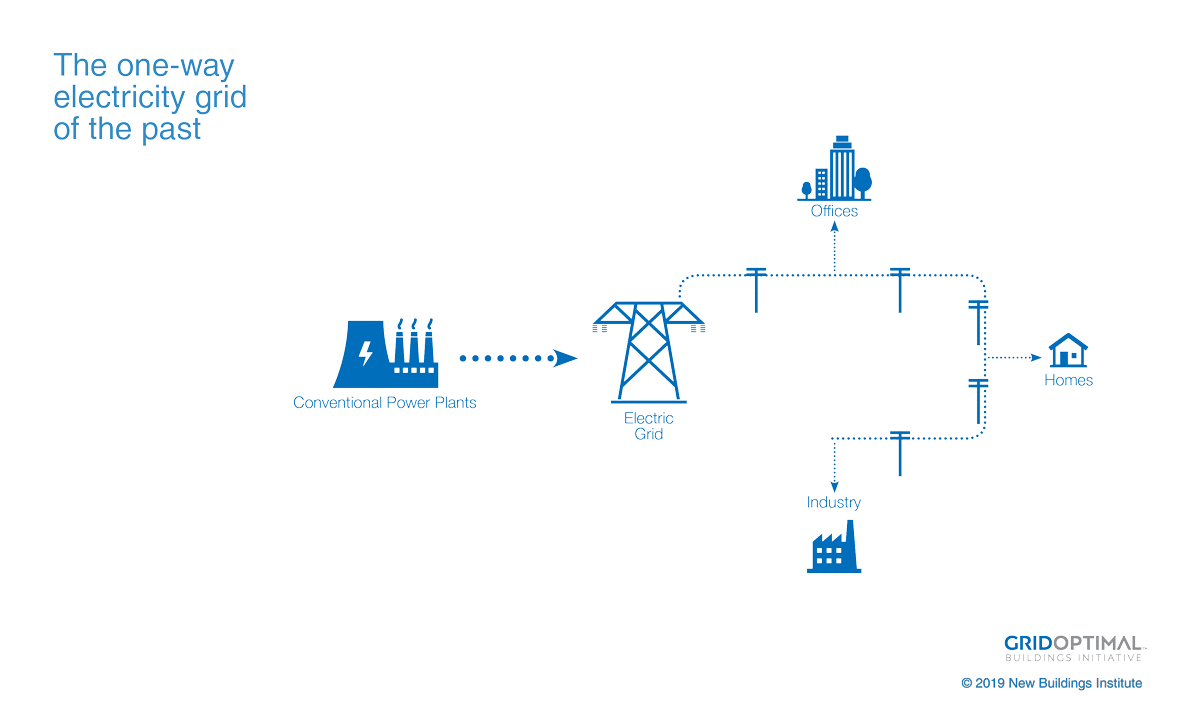
By creating a standardized set of metrics that define a building’s contribution to the relevant utility grid scale—the building’s operational performance as a grid asset—many doors open. Utilities may incentivize grid-sensitive design. Government agencies may include the metrics in their procurement requirements or in their climate policies. Designers and building owners can consider these impacts in a project in a sensible, straightforward approach. As we develop a way to define building-grid interaction quality, the market can respond by developing solutions for many of the issues facing the utility grid today and tomorrow. Future building codes can begin to encourage the adoption of these solutions and help ensure that the buildings coming online are acting as good grid citizens.
The Problem
Building occupants expect reliable, high-quality electricity on demand, regardless of what occurs behind the meter to meet that demand. For more than a century, the power grid has relied on one-way energy flows from large, centralized power plants, usually powered by fossil fuels. Today, new policies, such as carbon emissions reduction targets and new technology (including vastly cheaper renewable energy and energy storage) are forcing grid operators to seek a new paradigm. There has been, and will continue to be, huge distributed energy resouce (DER) growth in neighborhoods around the country. Bridging the gap between yesterday’s centralized, fossil-powered grid and tomorrow’s DER-rich, low-carbon grid will require new thinking and new strategies.
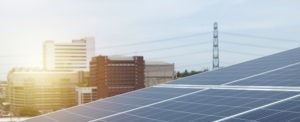 Building-scale strategies are a critical component of the transformation of the power grid and the decarbonization of our society. However, at the building-level, there is a real lack of knowledge and incentive to encourage grid-friendly design and operation, even though buildings built today may interact with the grid for a century or more. It is illuminating to consider the impacts of individual buildings on the grid through the lens of a building’s “grid citizenship.” A good grid citizen is a building that contributes to, rather than detracts from, the reliable, safe, and affordable operation of the grid.
Building-scale strategies are a critical component of the transformation of the power grid and the decarbonization of our society. However, at the building-level, there is a real lack of knowledge and incentive to encourage grid-friendly design and operation, even though buildings built today may interact with the grid for a century or more. It is illuminating to consider the impacts of individual buildings on the grid through the lens of a building’s “grid citizenship.” A good grid citizen is a building that contributes to, rather than detracts from, the reliable, safe, and affordable operation of the grid.
Across North America, there are no metrics in use today that define building-level grid citizenship or rate building-grid interaction quality in this way. Current thinking on the topic is fragmented and different players are using different language to discuss the topic from a variety of perspectives.
The Solution
NBI and the USGBC have developed a collaborative and inclusive process to create standards and tools to meet the new challenges of supporting a low carbon grid. The initiative aims to provide standards, tools, and guidance to improve building-grid interactions in the built environment by empowering owners, architects, and engineers with dedicated metrics, strategies, and pilot projects. The initiative builds on NBI’s proven leadership on this issue, and on the market reach of the Leadership in Energy and Environmental Design (LEED) green building rating system to develop and deploy these new metrics across the market.
GridOptimal metrics and the strategies underlying this work will play a major role in bridging the gap in knowledge, understanding, and priorities between the two sides of the grid: operators and consumers. The initiative will support carbon emissions reduction policy goals while ensuring that buildings enhance the affordability, reliability, and safety of the grid today and in the future.
Current focus areas for GridOptimal include the development of utility program criteria, market-facing design guidance, and deployment of metrics and other materials through codes, standards, and policy.
Resources
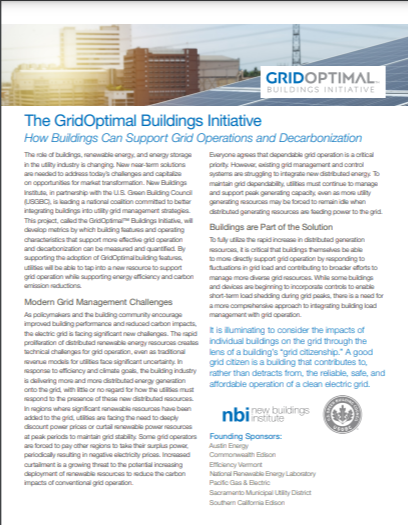
GridOptimal Factsheet
This factsheet outlines the key components of the GridOptimal Buildings Initiative and explains how buildings can support grid operation and decarbonization. Learn about the challenges of modern grid management, how buildings can be a part of the solution to support grid operation, and how the GridOptimal Buildings Initiative will overall help to decarbonize both buildings and the grid.
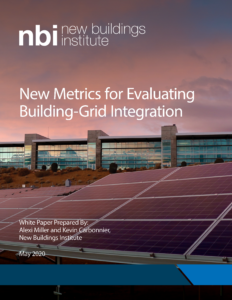 New Metrics for Evaluating Building-Grid Integration
New Metrics for Evaluating Building-Grid Integration
Since mid-2018, the not-for-profit, multi-stakeholder GridOptimal Buildings Initiative (GridOptimal 2020) has been developing metrics to measure the grid impacts of building features and operating characteristics to support a new design approach that prioritizes better building-grid integration across the building stock. Standardized metrics that quantitatively define a building’s operational performance as a grid asset will catalyze market development for grid-interactive buildings.
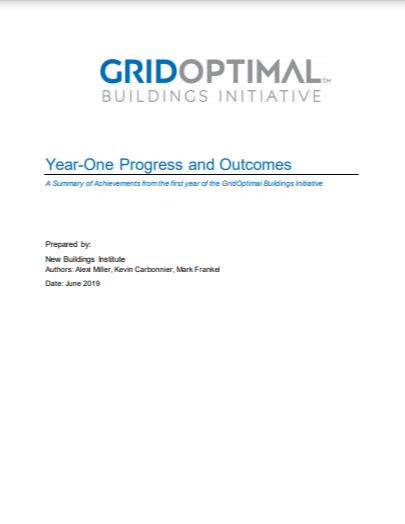
GridOptimal Phase 1 & 2 Outcomes
The GridOptimal™ Buildings Initiative focuses primarily on developing metrics by which building features and operating characteristics that support more effective grid operation can be measured and quantified. This Phase 1 document describes the work completed by the GridOptimal project team during the first phase of the project, from July 2018 to June 2019 ,while the Phase 2 document is for the time period of July 2019 to June 2020.
GridOptimal Building Design and Operations Fact Sheets
These easy-to-understand fact sheets provide key context and recommend selected high-impact building design and operations strategies for a variety of building types and U.S. regions.
| Optimizing Building Grid Integration in Building Types | Optimizing Building Grid Integration in U.S. Regions |
| Office Buildings | Southwest United States |
| Education Buildings | Northwest United States |
| Multifamily Buildings | Texas and the Southern Great Plains |
| Single Family Homes | Northern Great Plains |
| Retail Buildings | Midwest and Mid-Atlantic |
| Warehouses | Northeast United States |
| Southeast United States |
Webinars
| Getting to Zero: Grid Integrated Buildings | Original Air Date: 2/28/2019 | View Slides |
| GridOptimal: Outcomes and Lessons Learned from the First Pilot Project | Original Air Date: 1/30/2020 | View Slides |
| The GridOptimal Buildings Initiative Phase 1: Metrics, Modeling, and Momentum | Original Air Date: 4/29/2021 | View Slides |
GridOptimal is a joint effort of NBI and the U.S. Green Building Council. The initiative is currently supported by: Southern California Edison; Austin Energy; Pacific Gas & Electric Company; Sacramento Municipal Utility District; Efficiency Vermont, and Energy Trust of Oregon.
Questions? Contact Alexi Miller, PE, LEED-AP+ Associate Technical Director, [email protected]

